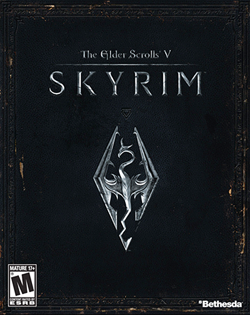
Under the crush of autumn releases—CoD:MW3, Uncharted 3, Sonic Generations, Battlefield 3 and Batman: Arkham City, to name just a handful—one game stands out in both its glowing public reception and its disastrous effects on this reviewer’s study habits: Bethesda Game Studios’ latest epic, The Elder Scrolls V: Skyrim.
Skyrim brought in an estimated $450 million in its first five days on the shelves. Standing back to back with Modern Warfare 3’s $775 million week, that might not look like much, but consider that Skyrim is an unapologetic fantasy game rife with dungeons and, yes, dragons—Skyrim’s mainstream success is a victory for innovative game development over the crippling narrowness of the role-playing genre.
And honestly, anyone shying away from Skyrim’s nerdiness is missing out on the most rewarding celebration of imagination and immersion to come along in years.
Now, as before, Bethesda lays before the player a world sprawling in scale and crackling with possibility: the Elder Scrolls series is celebrated for an open-ended approach to narrative that allows the player to follow the central story at his or her own pace, pursue an endlessly branching network of side-quests or just throw it out altogether and gallop the jagged, beautifully rendered countryside in search of unscripted entertainment—think Grand Theft Auto: Middle Earth or imagine if Tolkien’s saga had been one massive choose-your-own-adventure.
This is a tried-and-true model for Bethesda, so changes since Elder Scrolls IV: Oblivion (released in 2006) are largely those of approachability. Bethesda has nixed the convoluted class system that made OCD-inducing character-building a staple (and crutch) of previous titles, shifting the focus from number-crunching to the real meat of the game, good old-fashioned adventuring.
And oh, the adventures you will have: Bethesda assigned one cadre of developers the sole task of imagining dungeons, caves and castles—the self-contained story-worlds that dapple Skyrim’s landscape—and the results are breathtaking. Cathedral caverns, looming fortresses and yawning mines have palpable character, all the more memorable in that they are discovered, never paraded. (Looking at you, Dragon Age.)
Exploration is encouraged by optional missions, and the possibilities for quests are, quite literally, endless. The “Radiant Story” system continually generates quests that take the player to as-yet unexplored corners of the world or reflect previous choices.
And player actions do have a material impact on the world. You might be short on gold, but know that robbing the blacksmith will hurt his village’s economy, and don’t off a noble without expecting his brother to wake you with a dagger some weeks later, thirsty for vengeance.
Aside from scaring the hell out of the player (read: me), dynamic events like these give Skyrim a staggering actuality, a sense that you really have crossed over into a world that lives, breathes and wants to kill you.
Bolstered by hugely improved visuals and streamlined mechanics, Skyrim’s fully realized universe makes it far and away the most gripping game out this fall. Utterly immersed and given all the necessary tools, you find yourself constructing elaborate narratives that have nothing at all to do with scripted story; they are absorbing, personal and organic, and before you know it, the sun is coming up and you still have reading to do.
For better or worse, the question “Have you beat the game?” simply does not apply.
PHOTO COURTESY/WIKIMEDIA






